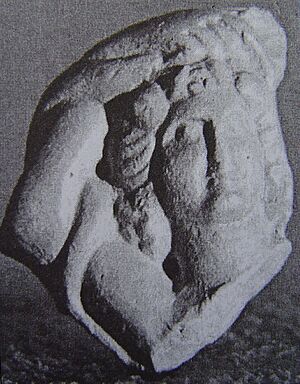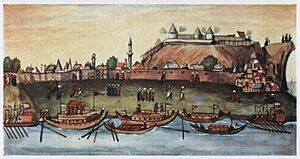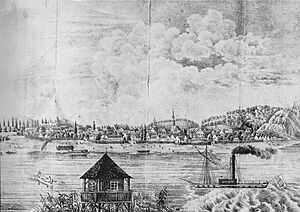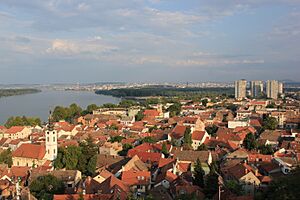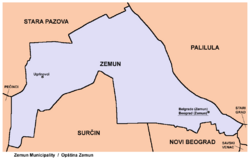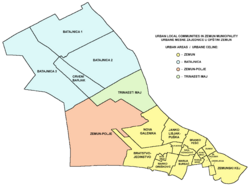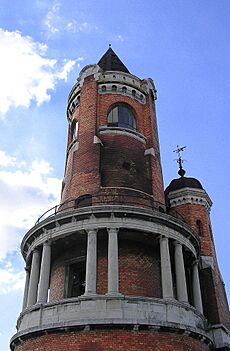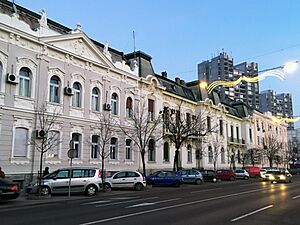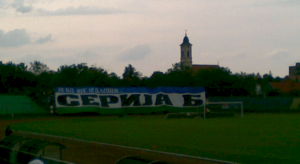Zemun facts for kids
Quick facts for kids
Zemun
Земун (Serbian)
|
|||
|---|---|---|---|
|
Municipality
|
|||
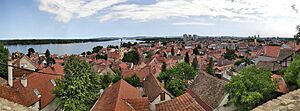
Panoramic view of Zemun from Gardoš Tower
|
|||
|
|||
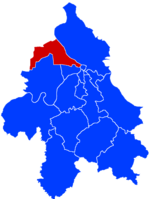
Location of Zemun within the city of Belgrade
|
|||
| Country | |||
| City | Belgrade | ||
| Settlements | 4 | ||
| Area | |||
| • Urban | 99.42 km2 (38.39 sq mi) | ||
| • Municipality | 149.77 km2 (57.83 sq mi) | ||
| Population
(2022)
|
|||
| • Municipality | 177,908 | ||
| Time zone | UTC+1 (CET) | ||
| • Summer (DST) | UTC+2 (CEST) | ||
| Postal code |
11080
|
||
| Area code | +381(0)11 | ||
| Car plates | BG | ||
Zemun (Serbian Cyrillic: Земун, pronounced [zěmuːn]; Hungarian: Zimony) is a lively part of Belgrade, the capital city of Serbia. It's located on the right bank of the Danube river, a bit upstream from downtown Belgrade. Zemun used to be a separate town, but it became part of Belgrade in 1934.
Over time, as Belgrade grew, the areas of Zemun and New Belgrade expanded and joined together. This made Zemun a continuous part of the larger city. According to the 2022 census, the municipality of Zemun has about 177,908 people living there. Besides the main town, the municipality also includes suburbs like Batajnica, Ugrinovci, Zemun Polje, and Nova Galenika.
Contents
What's in a Name?
In ancient times, the Celtic and Roman settlement here was called Taurunum. Later, during the Crusades in the 9th century, Frankish writers called it Mallevila.
Around the same time, the Slavic name Zemln was first written down. This name is thought to come from the word zemlja, which means soil or earth. This Slavic word is the root for all the names the city has had since, including the modern Serbian Zemun, Hungarian Zimony, and German Semlin.
A Look at History
People have lived in the Zemun area since the Neolithic period, which was a very long time ago! Graves and pottery from ancient cultures have been found here.
The first Celtic settlements in the Taurunum area appeared around the 3rd century BC. The Celts, called Scordisci, founded both Taurunum and Singidunum (which is now Belgrade). The Romans arrived in the 1st century BC, and Taurunum became part of the Roman province of Pannonia around 15 AD. It had a fortress and served as a port for the Roman fleet.
After many different groups ruled the area, the Kingdom of Hungary took control in the 12th century. Later, in the 15th century, it was given to the Serbian ruler Đurađ Branković. When the Serbian state fell to the Ottoman Empire in 1459, Zemun became an important military base.
In 1521, despite strong resistance, Zemun fell to the Ottoman army led by Suleyman the Magnificent. It remained under Ottoman rule for a long time.
From Ottoman to Habsburg Rule
The Austrian Habsburgs took over Zemun and southeastern Syrmia in 1717, after defeating the Ottomans. The Treaty of Passarowitz officially gave the town to the Habsburgs. In 1746, the Military Frontier was set up in the region, and Zemun gained special rights as a military community in 1749.
In 1777, Zemun had about 6,800 residents. Half of them were Serbs, while the other half included Germans, Hungarians, and Jews. Under Austrian rule, Zemun grew into an important trading and border city. It had a busy port on the Danube and was a major fishing center. In the 19th century, its population grew to over 7,000 people.
Zemun also became a safe place for many Serbs fleeing Ottoman rule, including the leader Karadjordje in 1813.
Modern Times
During the Revolutions of 1848, Zemun was a key city for the Serbian autonomous region within the Habsburg Empire. However, it was later returned to the Military Frontier's control. When the Military Frontier was ended in 1881, Zemun became part of the Kingdom of Croatia-Slavonia, which was part of Austria-Hungary.
The first railway line connecting Zemun to the west was built in 1883, and a railway bridge over the Sava River followed in 1884.
The Zemun Fortress was where the first shots of World War I were fired, when the Austro-Hungarian army attacked Belgrade. Zemun was briefly occupied by the Serbian army, but then taken back by the Austro-Hungarians. It returned to Serbian control on November 5, 1918, and became part of the Kingdom of Serbs, Croats and Slovenes (later called Kingdom of Yugoslavia).
In 1934, bus lines were introduced to connect Zemun with Belgrade. During World War II, Zemun was occupied by the German army. A camp was established where many people, including Jews and Romani, lost their lives. The city was freed from Axis control in 1944 and has been part of Serbia ever since.
Geography and Landscape
The Municipality of Zemun covers about 153 square kilometers. It's located in the eastern Syrmia region, in the central-western part of Belgrade. The main urban area of Zemun is the northernmost and westernmost part of urban Belgrade.
Zemun borders the province of Vojvodina to the west and other Belgrade municipalities like Surčin and Novi Beograd. The core of Zemun includes neighborhoods like Donji Grad, Gardoš, Ćukovac, and Gornji Grad. To the south, it connects with Novi Beograd, forming one continuous urban area.
Zemun originally developed on three "hills": Gardoš, Ćukovac, and Kalvarija. These aren't natural hills, but rather parts of a loess plateau that were shaped by the Danube River and human activity over centuries. The Danube used to flood the area, carving channels. People then built paths along these channels, creating the appearance of hills. A long stone levee was built along the Danube's bank from 1876 to 1889 to prevent flooding.
The Danube bank to the north is mostly marshy, so settlements like Batajnica are built further away. The city of Zemun itself is right on the bank, about 100 meters above sea level. The loess plateau here is very fertile, with rich soil. The uninhabited river islands of Great War Island and Little War Island on the Danube also belong to Zemun.
The loess cliff of Zemun, which is 30 to 40 meters high, was protected in 2013. It's a great example of dry land loess and is estimated to be 500,000 years old!
Exploring the Lagums
A unique feature of Zemun's landscape are the lagums. These are artificial underground tunnels that crisscross beneath the loess areas of Gardoš, Muhar, Ćukovac, and Kalvarija. The Romans started digging these tunnels at least 1,700 years ago, mainly to store food. Later, they were also used for supplies and even as hiding places.
The loess soil is good for digging because it's strong and durable, but it turns into sand when wet. The lagums stay cool, around 16°C (61°F).
During the Ottoman period, the Turkish rulers didn't use the lagums much. But when the Austrians took over Zemun, they used the underground tunnels to store ammunition. This is where the stories of a huge network of tunnels connecting Zemun and Belgrade under the Sava River began, though historians say this is unlikely.
After World War II, as the city grew, many new residents didn't know about the lagums. Without proper sewage systems, water seeped into the ground, making the loess wet and causing the tunnels to collapse. This made houses unstable. In 1988, authorities had to fill the largest lagum with concrete to stabilize the ground.
Despite some collapses, many lagums are still unexplored. So far, 76 long corridors have been found, with a total explored length of about 1,925 meters. These tunnels cover an area of about 4,882 square meters.
The lagums are an important part of Zemun's identity. For generations of local boys, exploring these tunnels was a kind of coming of age adventure. Even the name Zemun is linked to the word zemlja (earth) or zemunica (a dug-out shelter).
Neighborhoods and Suburbs
The municipality of Zemun officially has two main settlements: Belgrade (Zemun), which is the urban part, and the village of Ugrinovci, which includes smaller areas called Grmovac and Busije. Many new neighborhoods have grown in recent decades, such as Altina and Plavi Horizonti.
Here are some of the urban neighborhoods:
- 13. Maj
- Altina
- Batajnica
- Ćukovac
- Donji Grad
- Galenika
- Gardoš
- Gornji Grad
- Kalvarija
- Kamendin
- Lido
- Nova Galenika
- Novi Grad
- Plavi Horizonti
- Retenzija
- Sava Kovačević
- Zemun Polje
- Zemunski Kej
The main suburban area is:
- Ugrinovci (including Busije and Grmovac)
Population Growth
Zemun has grown a lot since World War II, becoming one of Belgrade's most populated areas. In 2022, the urban population of Zemun was 166,049, and the entire municipality had 177,908 residents.
Most people living in Zemun are Serbs, making up about 84% of the population. Other groups include Romani, Croats, Montenegrins, and many others, showing the diverse mix of people in the municipality.
Getting Around Zemun
Roads and Bridges
Several important roads in Serbia pass through Zemun, including the Belgrade-Zagreb highway and the road to Novi Sad.
For a long time, Zemun didn't have any permanent bridges, except for a temporary pontoon bridge that connects to the Great War Island in summer. However, the first permanent bridge over the Danube, the Pupin Bridge, was finished in 2014. It connects Zemun to Borča.
There are plans to improve the transport system, including a new main freight station for trains in Zemun.
River Transport
In 2014, plans were made to revitalize the old port area. In 2018, it was announced that a pier for tourist ships and cruisers would be built near the Old Port Authority. This pier, finished in 2020, is designed to welcome large ships and is Belgrade's second international tourist pier.
Air Travel
The Batajnica Airbase, which also handles some civil flights, is located in the municipality near the Batajnica settlement.
Culture and Learning
The White Bear Tavern in the neighborhood of Ćukovac is the oldest surviving building in urban Belgrade, dating back to 1658. However, because Zemun was separate from Belgrade for centuries, the House at 10 Cara Dušana Street in Belgrade is usually called the oldest house in Belgrade, while the White Bear Tavern is known as the oldest in Zemun.
Zemun has a rich cultural scene. The first professional theater in Zemun opened in 1969. The Madlenianum Opera and Theatre, founded in 1997, was the first private opera house in this part of Europe.
The Faculty of Agriculture of the Belgrade University is located in Zemun. There are also many other important schools and institutes, including those for internal affairs, economics, and medicine. Zemun also has a Homeland Museum.
Two of Belgrade's major hospitals, KBC Zemun and KBC Bežanijska Kosa, are in Zemun. The area is also home to many churches, including the Gardoš cemetery church and two Roman Catholic churches.
Zemun is known for its many small squares, such as Magistratski and Veliki. The bank of the Danube has been turned into Zemunski Kej, a long promenade with cafes, an amusement park, and the famous Hotel Jugoslavija.
The ruins of the old town, known as Zemunski Grad, are from a medieval fortress. The Kula Sibinjanin Janka (Tower of Janos Hunyadi), also called the Millennium Tower, was built in 1896 to celebrate a thousand years of Hungarian settlement. This tower is now a symbol of Zemun, and the Gardoš neighborhood has kept its old look with narrow, cobblestone streets.
Zemun has five official parks, with the largest and oldest being the City Park, opened in 1886. There are also several forests, including the Great and Little War Islands.
Sports in Zemun
The most popular football club in Zemun is FK Zemun, which plays in the Serbian First League. Another club, Teleoptik Zemun, is often considered a farm team for Partizan Belgrade, helping young players gain experience. Zemun has several stadiums, including the Zemun Stadium. The Pinki Hall, a major sports hall in Belgrade, is also located here.
International Connections
Zemun is twinned with many cities around the world, meaning they have special friendly relationships and often work together on projects. Some of these cities include:
 Al-Ram, State of Palestine
Al-Ram, State of Palestine Banja Luka, Bosnia and Herzegovina
Banja Luka, Bosnia and Herzegovina Bitola, North Macedonia
Bitola, North Macedonia Esch-sur-Alzette, Luxembourg
Esch-sur-Alzette, Luxembourg Herceg Novi, Montenegro
Herceg Novi, Montenegro Kranj, Slovenia
Kranj, Slovenia Corfu, Greece
Corfu, Greece Tower Hamlets, United Kingdom
Tower Hamlets, United Kingdom Mödling, Austria
Mödling, Austria Offenbach am Main, Germany
Offenbach am Main, Germany Ohrid, North Macedonia
Ohrid, North Macedonia Osijek, Croatia
Osijek, Croatia Puteaux, France
Puteaux, France Rif Dimashq, Syria
Rif Dimashq, Syria Tilburg, Netherlands
Tilburg, Netherlands Velletri, Italy
Velletri, Italy Veroia, Greece
Veroia, Greece
Famous People from Zemun
Many notable people have come from Zemun, including:
- Judah Alkalai
- Dejan Čurović
- Ivan Dudić
- Aleksandar Karakašević
- Saša Kovačević
- Mladen Lazarević
- Ljubomir Magaš
- Goran Milošević
- Zoran Modli
- Vladica Popović
- Jovan Prokopljević
- Ivan Pudar
- Radovan Radaković
- Slavko Radovanović
- Đorđe Simić
- Jakov Mrvica
See also
- Monastery of St. Archangel Gabriel, Zemun
- Subdivisions of Belgrade
- List of Belgrade neighbourhoods and suburbs
Images for kids





